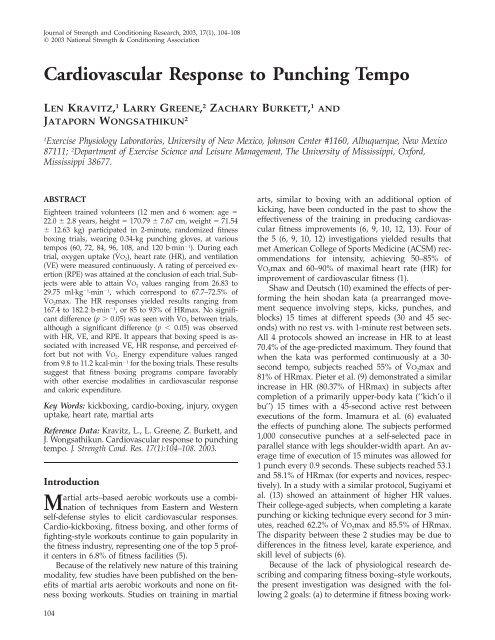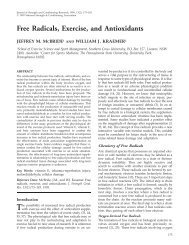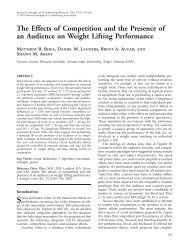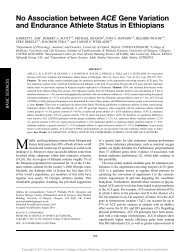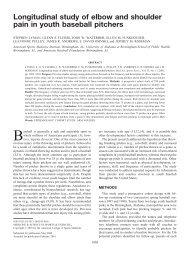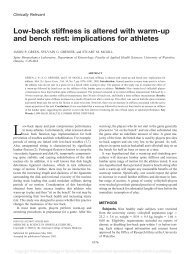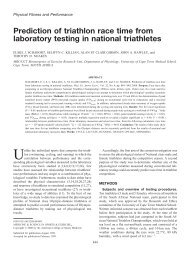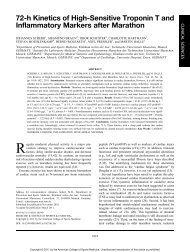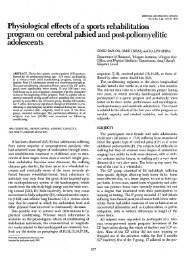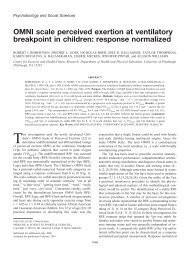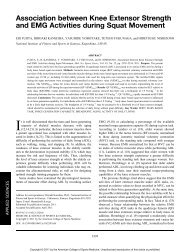Cardiovascular Response to Punching Tempo - Setanta College
Cardiovascular Response to Punching Tempo - Setanta College
Cardiovascular Response to Punching Tempo - Setanta College
Create successful ePaper yourself
Turn your PDF publications into a flip-book with our unique Google optimized e-Paper software.
Journal of Strength and Conditioning Research, 2003, 17(1), 104–108<br />
� 2003 National Strength & Conditioning Association<br />
<strong>Cardiovascular</strong> <strong>Response</strong> <strong>to</strong> <strong>Punching</strong> <strong>Tempo</strong><br />
LEN KRAVITZ, 1 LARRY GREENE, 2 ZACHARY BURKETT, 1 AND<br />
JATAPORN WONGSATHIKUN 2<br />
1 Exercise Physiology Labora<strong>to</strong>ries, University of New Mexico, Johnson Center #1160, Albuquerque, New Mexico<br />
87111; 2 Department of Exercise Science and Leisure Management, The University of Mississippi, Oxford,<br />
Mississippi 38677.<br />
ABSTRACT<br />
Eighteen trained volunteers (12 men and 6 women: age �<br />
22.0 � 2.8 years, height � 170.79 � 7.67 cm, weight � 71.54<br />
� 12.63 kg) participated in 2-minute, randomized fitness<br />
boxing trials, wearing 0.34-kg punching gloves, at various<br />
tempos (60, 72, 84, 96, 108, and 120 b·min�1 ). During each<br />
trial, oxygen uptake (V˙ O2), heart rate (HR), and ventilation<br />
(VE) were measured continuously. A rating of perceived exertion<br />
(RPE) was attained at the conclusion of each trial. Subjects<br />
were able <strong>to</strong> attain V˙ O2 values ranging from 26.83 <strong>to</strong><br />
29.75 ml·kg�1 ·min�1 , which correspond <strong>to</strong> 67.7–72.5% of<br />
V˙ O2max. The HR responses yielded results ranging from<br />
167.4 <strong>to</strong> 182.2 b·min�1 , or 85 <strong>to</strong> 93% of HRmax. No significant<br />
difference (p � 0.05) was seen with V˙ O2 between trials,<br />
although a significant difference (p � 0.05) was observed<br />
with HR, VE, and RPE. It appears that boxing speed is associated<br />
with increased VE, HR response, and perceived effort<br />
but not with V˙ O2. Energy expenditure values ranged<br />
from 9.8 <strong>to</strong> 11.2 kcal·min�1 for the boxing trials. These results<br />
suggest that fitness boxing programs compare favorably<br />
with other exercise modalities in cardiovascular response<br />
and caloric expenditure.<br />
Key Words: kickboxing, cardio-boxing, injury, oxygen<br />
uptake, heart rate, martial arts<br />
Reference Data: Kravitz, L., L. Greene, Z. Burkett, and<br />
J. Wongsathikun. <strong>Cardiovascular</strong> response <strong>to</strong> punching<br />
tempo. J. Strength Cond. Res. 17(1):104–108. 2003.<br />
Introduction<br />
Martial arts–based aerobic workouts use a combination<br />
of techniques from Eastern and Western<br />
self-defense styles <strong>to</strong> elicit cardiovascular responses.<br />
Cardio-kickboxing, fitness boxing, and other forms of<br />
fighting-style workouts continue <strong>to</strong> gain popularity in<br />
the fitness industry, representing one of the <strong>to</strong>p 5 profit<br />
centers in 6.8% of fitness facilities (5).<br />
Because of the relatively new nature of this training<br />
modality, few studies have been published on the benefits<br />
of martial arts aerobic workouts and none on fitness<br />
boxing workouts. Studies on training in martial<br />
104<br />
arts, similar <strong>to</strong> boxing with an additional option of<br />
kicking, have been conducted in the past <strong>to</strong> show the<br />
effectiveness of the training in producing cardiovascular<br />
fitness improvements (6, 9, 10, 12, 13). Four of<br />
the 5 (6, 9, 10, 12) investigations yielded results that<br />
met American <strong>College</strong> of Sports Medicine (ACSM) recommendations<br />
for intensity, achieving 50–85% of<br />
V˙ O2max and 60–90% of maximal heart rate (HR) for<br />
improvement of cardiovascular fitness (1).<br />
Shaw and Deutsch (10) examined the effects of performing<br />
the hein shodan kata (a prearranged movement<br />
sequence involving steps, kicks, punches, and<br />
blocks) 15 times at different speeds (30 and 45 seconds)<br />
with no rest vs. with 1-minute rest between sets.<br />
All 4 pro<strong>to</strong>cols showed an increase in HR <strong>to</strong> at least<br />
70.4% of the age-predicted maximum. They found that<br />
when the kata was performed continuously at a 30second<br />
tempo, subjects reached 55% of V˙ O2max and<br />
81% of HRmax. Pieter et al. (9) demonstrated a similar<br />
increase in HR (80.37% of HRmax) in subjects after<br />
completion of a primarily upper-body kata (‘‘kich’o il<br />
bu’’) 15 times with a 45-second active rest between<br />
executions of the form. Imamura et al. (6) evaluated<br />
the effects of punching alone. The subjects performed<br />
1,000 consecutive punches at a self-selected pace in<br />
parallel stance with legs shoulder-width apart. An average<br />
time of execution of 15 minutes was allowed for<br />
1 punch every 0.9 seconds. These subjects reached 53.1<br />
and 58.1% of HRmax (for experts and novices, respectively).<br />
In a study with a similar pro<strong>to</strong>col, Sugiyami et<br />
al. (13) showed an attainment of higher HR values.<br />
Their college-aged subjects, when completing a karate<br />
punching or kicking technique every second for 3 minutes,<br />
reached 62.2% of V˙ O2max and 85.5% of HRmax.<br />
The disparity between these 2 studies may be due <strong>to</strong><br />
differences in the fitness level, karate experience, and<br />
skill level of subjects (6).<br />
Because of the lack of physiological research describing<br />
and comparing fitness boxing–style workouts,<br />
the present investigation was designed with the following<br />
2 goals: (a) <strong>to</strong> determine if fitness boxing work-
outs can provide male and female participants an adequate<br />
level of intensity, as measured by HR, ratings<br />
of perceived exertion (RPE), and V˙ O2, <strong>to</strong>improvecardiovascular<br />
function, and (b) <strong>to</strong> detect if any of the<br />
commonly used boxing tempos (60, 72, 84, 96, 108, and<br />
120 b·min �1 ) in fitness boxing classes has a greater cardiovascular<br />
response.<br />
Methods<br />
Experimental Approach <strong>to</strong> the Problem<br />
To determine whether fitness boxing workouts can<br />
provide an adequate intensity stimulus <strong>to</strong> improve cardiovascular<br />
capacity, we recruited physically active<br />
men and women who had fitness boxing experience.<br />
All subjects were trained by the same certified boxing<br />
instruc<strong>to</strong>r in at least 30 different training sessions and<br />
thus received similar instructions on boxing techniques,<br />
punching exertion, and exercise intensity. All<br />
training sessions were approximately 1 hour in duration.<br />
The aim of our second question was <strong>to</strong> determine<br />
if any commonly used boxing tempos elicited a greater<br />
cardiovascular response. Therefore, <strong>to</strong> minimize any<br />
extraneous effects, subjects were familiarized with the<br />
different punching tempos (60, 72, 84, 96, 108, and 120<br />
b·min �1 ) during their training program.<br />
Subjects<br />
Twelve men and 6 women, 20–32 years of age, recruited<br />
from boxing exercise classes at a local wellness facility<br />
volunteered for this study. Subjects provided<br />
written informed consent after the purpose and pro<strong>to</strong>col<br />
of the study were explained <strong>to</strong> them. The University<br />
Institutional Review Board approved this<br />
study.<br />
Trial Testing Pro<strong>to</strong>col<br />
On arrival at the exercise physiology labora<strong>to</strong>ry, the<br />
body weight and height (without shoes) of the subject<br />
were measured initially on each testing day. The trial<br />
testing pro<strong>to</strong>col involved 2-minute boxing bouts with<br />
a commercial boxing device (SLAMMAN, Fitness<br />
Quest, Can<strong>to</strong>n, OH), with the subjects wearing 0.34kg<br />
boxing gloves provided with the product. Before<br />
trial testing, all subjects performed a 3-minute warmup<br />
on a cycle ergometer at a self-selected pace and<br />
resistance setting. This was followed by a 3-minute familiarization<br />
period with the boxing device, with the<br />
subjects performing contact punching against the boxing<br />
equipment, which was similar <strong>to</strong> how they were<br />
trained. Subjects then sat in a firm back chair for 5<br />
minutes <strong>to</strong> establish a baseline recovery HR. Only HR<br />
data were collected during the recovery period between<br />
trials.<br />
Trials were ordered in a randomized balanced Latin<br />
square design at the following tempos: 60, 72, 84,<br />
96, 108, and 120 b·min �1 , which were established with<br />
a metronome. Before each boxing trial, subjects sat in<br />
<strong>Punching</strong> <strong>Tempo</strong> 105<br />
the same chair for a minimum of 3 minutes, and until<br />
their recovery HR was within 10 b·min �1 of their<br />
warm-up recovery HR. The boxing movements included<br />
a self-selected combination of alternating right and<br />
left jabs, hooks, and straight punches that the subjects<br />
practiced in their boxing classes. During these boxing<br />
movements, the subjects’ line of gravity moved slightly<br />
beyond the shoulder-width stance. Therefore, the body<br />
weight consistently shifted from leg <strong>to</strong> leg <strong>to</strong> maintain<br />
equilibrium. Before each trial, subjects were instructed<br />
<strong>to</strong> punch <strong>to</strong> the tempo of the metronome. The V˙ O2,<br />
V˙ CO2, respira<strong>to</strong>ry exchange ratio (RER), and ventilation<br />
(VE) were measured continuously and averaged<br />
every 10 seconds using a SensorMedics 2900 Metabolic<br />
Measurement Cart (SensorMedics, Yorba Linda, CA).<br />
Pretest calibration and posttest verification of calibration<br />
were conducted for all tests using standard medical<br />
grade gases for the gas analyzers and a 3.0-L syringe<br />
for the flow meter. The HR was obtained every<br />
30 seconds with a Polar Favor Heart watch (Polar Inc.,<br />
Woodbury, NY). Caloric expenditure was calculated<br />
using the following equation: V˙ O2(L·min �1 ) �<br />
RER(V˙ CO2/V˙ O2). During recovery between trials, subjects<br />
reported an RPE (3) for the overall trial.<br />
Body Composition and Maximal Aerobic Capacity<br />
Testing<br />
On a separate day, subjects reported at the exercise<br />
physiology labora<strong>to</strong>ry <strong>to</strong> assess body density using<br />
standardized 3-site skinfold procedures. From the<br />
measured body densities, body fat (BF) percentages<br />
were calculated using the Lohman (7) equation for<br />
women, %BF � [(5.03/body density [Db]) � 4.59] �<br />
100, and the Siri (11) equation for men, %BF � [(4.95/<br />
Db) � 4.5] � 100.<br />
The V˙ O2max, HRmax, and RPEmax were determined<br />
using an individualized graded exercise treadmill<br />
test (GXT) <strong>to</strong> the point of exhaustion. For attaining<br />
V˙ O2max, any 3 of the following criteria had <strong>to</strong> be satisfied:<br />
RER � 1.15, failure of HR <strong>to</strong> increase more then<br />
4 b·min �1 with increases in exercise intensity, RPEmax<br />
� 17, or a plateau of 150 ml O 2 with an increasing<br />
workload (1). The GXTs began with a 1-minute walk<br />
at 107.2 m·min �1 and 0% grade, followed by an increase<br />
in velocity by 13.4 m·min �1 every minute till a<br />
comfortable running speed was attained. Speed was<br />
then kept constant, and grade was increased by 2–3%<br />
every minute until volitional fatigue was achieved. All<br />
maximal tests lasted between 9 and 12 minutes, with<br />
at least 3 of the 4 criteria satisfied.<br />
Statistical Analyses<br />
Descriptive statistics were obtained for all variables.<br />
Dependent variables were V˙ O2, HR, VE, kcal·min �1 ,<br />
and RPE. The independent variable was punching tempo<br />
(60, 72, 84, 96, 108, and 120 b·min �1 ). A repeated<br />
measures multivariate analysis of variance (MANOVA)
106 Kravitz, Greene, Burkett, and Wongsathikun<br />
Table 1. Subject characteristics (mean � SD) and ranges<br />
(N � 18).<br />
Variables Mean � SD Range<br />
Age (y)<br />
Height (cm)<br />
Body weight (kg)<br />
Body fat (%)<br />
HRmax (b·min �1 )<br />
V˙ O2max (ml·kg �1 ·min �1 )<br />
RPEmax (units)<br />
22.0 � 2.8<br />
170.8 � 7.7<br />
71.5 � 12.6<br />
16.1 � 7.3<br />
195.7 � 7.0<br />
41.04 � 6.5<br />
18.6 � 0.8<br />
20–32<br />
157–187<br />
53–92<br />
4.8–28.6<br />
182–220<br />
29.4–52.3<br />
17–20<br />
Figure 1. Heart rate trial responses <strong>to</strong> boxing tempos. 120<br />
� 60, 72, 84, 96 b·min �1 ; 108 � 60, 72 b·min �1 ;96� 60<br />
b·min �1 .<br />
was used for physiological data analysis. In the event<br />
of a significant Wilk’s Lambda, repeated measures<br />
analysis of variance (ANOVA) was used. Where indicated,<br />
posthoc contrast comparisons were used <strong>to</strong><br />
identify significant differences between trial means. A<br />
Friedman nonparametric ANOVA was used <strong>to</strong> analyze<br />
the RPE data. Statistical significance was set a priori at<br />
a probability level of p � 0.05.<br />
Results<br />
Table 1 depicts the subject’s descriptive characteristics.<br />
The MANOVA analysis revealed a significant Wilk’s<br />
Lambda (F � 2.614, p � 0.05). The subsequent univariate<br />
analyses showed a significant trial effect for<br />
HR (F � 5.2, p � 0.05) (Figure 1), VE (F � 4.8, p �<br />
0.05) (Figure 2), and kcal·min �1 (F � 2.8, p � 0.05)<br />
(Figure 3) but not for V˙ O2 (F � 1.6, p � 0.05) (Figure<br />
4). For HR, significance was attained when boxing<br />
tempos varied by �24 b·min �1 , beginning at the 96<br />
b·min �1 speed. Similarly, significance was shown in VE<br />
and kcal·min �1 when the boxing tempo difference was<br />
�24 b·min �1 between trials and the tempo was 84<br />
b·min �1 or above. For RPE, the Friedman nonparamet-<br />
Figure 2. Ventilation trial responses <strong>to</strong> boxing tempos.<br />
120 � 60, 72, 84, 96 b·min �1 ; 108 � 60, 72 b·min �1 ;96� 60<br />
b·min �1 ;84� 60 b·min �1 .<br />
Figure 3. Caloric expenditure trial responses <strong>to</strong> boxing<br />
tempos. 120 � 60, 72 b·min �1 ; 108 � 60 b·min �1 ;84� 60<br />
b·min �1 .<br />
ric test revealed a significant trial difference (p � 0.05),<br />
with mean RPE ranks of 2.3, 2.4, 2.9, 3.2, and 4.2, for<br />
the 60-, 72-, 84-, 96-, 108-, and 120-b·min �1 trials, respectively<br />
(Figure 5). Subjects’ perception of work rose<br />
with each increase in punching tempo for all trials.<br />
Discussion<br />
In this study, 12 men and 6 women, with 30 hours of<br />
fitness boxing experience, completed 6 different<br />
punching trials (60, 72, 84, 96, 108, and 120 b·min �1 ),<br />
wearing 0.34-kg boxing gloves, <strong>to</strong> determine which<br />
tempos were best capable of meeting the ACSM guidelines<br />
for intensity of exercise. The purpose of this<br />
study was <strong>to</strong> provide a physiological basis on which<br />
<strong>to</strong> validate the program design and associated health<br />
benefits of this new exercise modality.
Figure 4. Oxygen uptake (V˙ O2) trial responses <strong>to</strong> boxing<br />
tempos.<br />
Figure 5. Rating of perceived exertion trial responses <strong>to</strong><br />
boxing tempos. Significant rank order difference between<br />
trials.<br />
The results of this investigation clearly show that<br />
fitness boxing at any of the 6 tempos can elicit a satisfac<strong>to</strong>ry<br />
oxygen uptake response for improving cardiovascular<br />
endurance based on the intensity guidelines<br />
set by the ACSM of 50–85% V˙ O2max (1). The percentage<br />
of oxygen uptake values can be seen in Figure<br />
6 and ranged from 67.9 <strong>to</strong> 72.3% of V˙ O2max for each<br />
of the 6 punching tempos. The current data suggest a<br />
much higher increase in V˙ O2 than was previously<br />
shown by Shaw and Deutsch (10) during a karate kata.<br />
This is <strong>to</strong> be expected based on the slower, more concise<br />
motions of the kata vs. the constant and repetitious<br />
actions of punching at high tempos. Our data is<br />
consistent with those obtained by Sugiyami et al. (13)<br />
in a study with 12 male collegiate karate athletes repeating<br />
a basic karate strike every second for 3 minutes,<br />
which yielded values of 62.2–74.4% V˙ O2max.<br />
<strong>Punching</strong> <strong>Tempo</strong> 107<br />
Figure 6. Percent maximum oxygen uptake (V˙ O2max) and<br />
maximum heart rate (HRmax) responses <strong>to</strong> boxing tempos.<br />
This investigation also sought <strong>to</strong> find out if a difference<br />
in oxygen uptake would be observed between<br />
commonly used boxing tempos. Figure 4 illustrates the<br />
relationship between V˙ O2 and punching tempo. No<br />
overall significant difference was observed. Although<br />
VE increased significantly because of punching tempo<br />
(Figure 2), these data indicate that the punching tempo<br />
did not directly alter the actual oxygen uptake of the<br />
subjects.<br />
There was a significant increase in RPE for all trials<br />
(Figure 5). This indicates that the subjects felt they<br />
were performing at a higher work level without the<br />
increase in V˙ O2 that would usually be associated with<br />
this increase. This may be associated <strong>to</strong> other variables,<br />
such as HR response, respira<strong>to</strong>ry rate, muscle fatigue,<br />
speed of movement, and joint stress.<br />
With this in mind, the prospect of increased injury<br />
rate at higher tempos is brought in<strong>to</strong> context. Because<br />
of the relatively new nature of this form of exercise, no<br />
data are available <strong>to</strong> support the notion that punching<br />
at a higher tempo leads <strong>to</strong> more injury. Research is<br />
available, however, on injury rates and suggested causes<br />
in the field of dance aerobics, which may be associated<br />
<strong>to</strong> this aerobic activity as well. Studies have reported<br />
that 80% of all dance and aerobic injuries are<br />
caused by overuse (4, 14). Vetter et al. (14) classified<br />
overuse injuries in<strong>to</strong> the following 2 categories: (a) accumulated<br />
microtrauma from repetitive movements<br />
that can lead <strong>to</strong> an inflamma<strong>to</strong>ry response, and (b) tissue<br />
with previous microtrauma that, if not given time<br />
<strong>to</strong> heal, can lead <strong>to</strong> muscle breakdown at a higher level.<br />
It seems plausible that repeated exposure <strong>to</strong> the<br />
faster punching tempos may give rise <strong>to</strong> overuse injuries.<br />
The HR response <strong>to</strong> different punching rates also<br />
was found <strong>to</strong> be capable of meeting and exceeding the<br />
ACSM guidelines of 60–90% maximal HR (1). These<br />
results, as shown in Figure 6, range from 85.6 <strong>to</strong> 93.1%<br />
of HRmax. The current data are similar <strong>to</strong> those reported<br />
by Pieter et al. (9), Sugiyama et al. (13), and
108 Kravitz, Greene, Burkett, and Wongsathikun<br />
Shaw and Deutsch (10), who reported values of 80–<br />
91%, 85.5–90.1%, and 70.4–81% HRmax, respectively.<br />
The explanation for the higher %HRmax response<br />
vs. that of the %V˙ O2max response (Figure 6) is perhaps<br />
the result of the high level of arm movement involved.<br />
Arm exercise tends <strong>to</strong> give a higher HR at a given<br />
oxygen uptake (2). Because this particular study was<br />
based on arm movements alone, the elevated HR response<br />
was expected.<br />
There was a significant increase in caloric expenditure<br />
between trials as shown in Figure 3. This increase,<br />
without a comparable increase in V˙ O2, is caused<br />
by the rise in RER throughout the trials. Because caloric<br />
expenditure was calculated by multiplying V˙ O2<br />
(L·min �1 ) and RER (V˙ CO2/V˙ O2), a direct relationship<br />
between kcal·min �1 and one or both variables was expected.<br />
Mean energy expenditure of the 6 boxing trials<br />
ranged from 9.78 <strong>to</strong> 11.2 kcal·min �1 and compared favorably<br />
with that of other martial arts and fitness activities<br />
(8).<br />
In summary, fitness boxing workouts meet and<br />
may exceed the criteria set forth by the ACSM for intensity<br />
of exercise <strong>to</strong> maintain and improve cardiorespira<strong>to</strong>ry<br />
fitness. The failure of V˙ O2 <strong>to</strong> significantly<br />
change with increasing tempo suggests that faster<br />
punching speeds are not as important for improved<br />
cardiovascular training. As seen with other repetition<br />
movement activities, the faster boxing tempos may<br />
even be contraindicated. Additional research is recommended<br />
<strong>to</strong> measure the force of contact of different<br />
boxing tempos, <strong>to</strong> study how boxing tempo affects<br />
participant fatigue levels, and <strong>to</strong> determine how <strong>to</strong><br />
maximize the health benefits of fitness boxing while<br />
minimizing the risk of injury.<br />
Practical Applications<br />
Martial arts and fitness boxing workouts have been<br />
shown <strong>to</strong> be a viable and highly popular mode of aerobic<br />
training. Many different programs exist, and even<br />
more are evolving based on basic martial art forms<br />
and boxing methods. The present study has shown<br />
clearly that an increase in tempo does not correspond<br />
<strong>to</strong> an increase in V˙ O2 or an associated increase in po-<br />
tential health benefits. Based on these data, it appears<br />
that when designing a fitness boxing program, slower<br />
punching tempos may be recommended. The potential<br />
risk of injury from higher punching rates and the increase<br />
in RPE further support this suggestion.<br />
References<br />
1. AMERICAN COLLEGE OF SPORTS MEDICINE. ACSM’s Guidelines for<br />
Exercise Testing and Prescription (5th ed.). Baltimore: Williams<br />
and Wilkins, 1995.<br />
2. ASTRAND, P.O., AND K. RODAHL. Textbook of Work Physiology.<br />
New York: McGraw-Hill Book Company, 1986.<br />
3. BORG, G.A.V. Perceived exertion. A note on ‘‘his<strong>to</strong>ry’’ and<br />
methods. Med. Sci. Sports Exerc. 5:90–93. 1973.<br />
4. GARRICK, J.G., D.M. GILLIEN, AND P. WHITESIDE. The epidemiology<br />
of aerobic dance injuries. Am. J. Sports Med. 14:67–72.<br />
1986.<br />
5. IHRSA. International Health, Racquet & Sportsclub Association.<br />
Available at: www.ihrsa.org/industrystats/programming.html.<br />
6. IMAMURA, H.,Y.YOSHIMURA, K.UCHIDA, A.TANAKA, S.NISH-<br />
IMURA, AND A.T. NAKAZAWA. Heart rate, blood lactate responses<br />
and ratings of perceived exertion <strong>to</strong> 1,000 punches and 1,000<br />
kicks in collegiate karate practitioners. Appl. Hum. Sci. 16:9–13.<br />
1997.<br />
7. LOHMAN, T.G. Advances in Body Composition Assessment. Champaign,<br />
IL: Human Kinetics, 1992.<br />
8. OLSON, M.S., AND H.N. WILLIFORD. Martial arts exercise, a<br />
T.K.O. in studio fitness. ACSM Health Fitness J. 3:6–14. 1999.<br />
9. PIETER, W.,D.TAAFFE, AND J. HEIJMANS. Heart rate response<br />
<strong>to</strong> taekwondo forms and technique combinations. J. Sports Med.<br />
Phys. Fitness 30:97–102. 1990.<br />
10. SHAW, D.K., AND D.T. DEUTSCH. Heart rate and oxygen uptake<br />
response <strong>to</strong> performance of karate kata. J. Sports Med. 22:461–<br />
468. 1982.<br />
11. SIRI, W.E. Body composition from fluid space and density.<br />
Analysis of methods. In: Techniques for Measuring Body Composition.<br />
J. Brozek and A. Henschel, eds. Washing<strong>to</strong>n, DC: National<br />
Academy of Sciences, 1961. pp. 223–224.<br />
12. STRICEVIC, M.,T.OKAZAKI, A.J. TANNER, N.MAZZARELLA, AND<br />
R. MEROLA. <strong>Cardiovascular</strong> response <strong>to</strong> the karate kata. Physician<br />
Sportsmed. 8:57–66. 1980.<br />
13. SUGIYAMI, M.,T.OHYAGI, H.KIRISHIMA, AND A. HIRATANI.Mo<strong>to</strong>r<br />
intensity of basics in karate. Jpn. J. Phys. Fitness Sports Med.<br />
31:134. 1982.<br />
14. VETTER, W.L., D.L. HELFET, K.SPEAR, AND L.S. MATTHEWS.Aerobic<br />
dance injuries. Physician Sportsmed. 13:114–120. 1985.<br />
Address correspondence <strong>to</strong> Dr. Len Kravitz,<br />
lkravitz@unm.edu.


